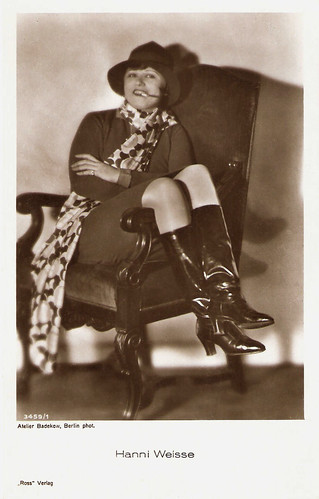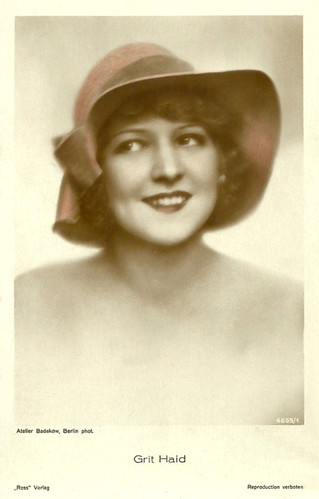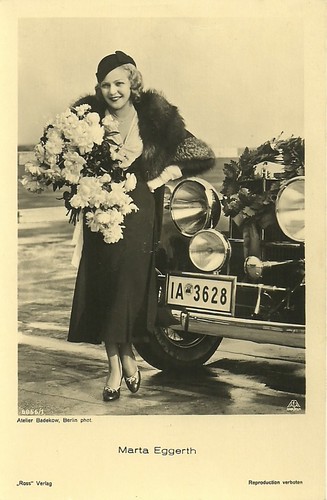The work of German photographer Martin Badekow (1896–1983) has been overlooked for a long time, but his photographs from the Berlin cabarets have become emblematic images of Weimar Germany. Vintage prints by Badekow are auctioned today for hundreds of dollars, but you can still find Ross Verlag postcards with his glamour portraits of film stars for the price of a bus fare.

Werner Krauss. German postcard by Ross Verlag, Berlin, no. 1613/1, 1927-1928. Photo: Atelier Badekow-Grosz, Berlin. Collection: Didier Hanson.

Werner Krauss. German postcard by Ross Verlag, Berlin, no. 1613/2, 1927-1928. Photo: Atelier Badekow-Grósz, Berlin.

Mary Kid. German postcard by Ross Verlag, Berlin, no. 3005/1, 1928-1929. Photo: Atelier Badekow, Berlin.

Warwick Ward. German postcard by Ross Verlag, Berlin, no. 3312/1, 1928-1929. Photo: Atelier Badekow, Berlin.

Warwick Ward. German postcard by Ross Verlag, no. 3312/2, 1928-1929. Signed in 1931. Photo: Atelier Badekow, Berlin.

Harry Hardt. German postcard by Ross Verlag, no. 3406/1, 1928-1929. Photo: Atelier Badekow, Berlin.

Hanni Weisse. German postcard by Ross Verlag, no. 3459/1, 1928-1929. Photo: Atelier Badekow Berlin.
Martin Badekow had his photo studio, Atelier Badekow, at the famous Kurfürstendamm in Berlin. There he and his compagnon Grosz produced many fashion photos and celebrity portraits.
During the 1920s, Martin Badekow was frequently referred to in the German press as 'famous' or 'world renowned'. Many film stars came to his studio for glamour portraits, including Henny Porten, Dita Parlo and the beautiful exotic dancer La Jana.
The then still unknown Marlene Dietrich also often posed at Badekow's studio for fashion photos, showing her beautiful legs. Badekow sold the pictures to the many illustrated magazines in Berlin. However none of his portraits of Marlene were used for Ross Verlag postcards.
A well-known 1927 photo by Badekow shows Marlene playing the singing saw, which she had learned to play ffor the silent (!) film Café Elektric/Café Electric (Gustav Ucicky, 1927). Her teacher was co-star Igo Sym, who later became a Gestapo agent and was liquidated by the Polish resistance. During the second World War, Dietrich would let the saw sing again for the US troops.
After the war, Martin Badekow and his son Heinz (1920) photographed the ruins of Berlin. Their devastating pictures of the city can be seen at Getty Images, including one of the destroyed Kurfürstendamm. In the following decades Badekow slowly disappeared from the radar, till his work of the 1920s suddenly became the focus of revived interest.
And today, Martin Badekow's photographs from the Berlin cabarets and the stars of the silent German cinema can be admired in museums and are worshipped as emblematic images of Weimar Germany.

Ernst Verebes. German postcard by Ross Verlag, no. 3693/1, 1928-1929. Photo: Atelier Badekow, Berlin.

La Jana. German postcard by Ross Verlag, no. 3911, 1928-1929. Photo: Atelier Badekow, Berlin. Collection: Didier Hanson.

Dita Parlo. German postcard by Ross Verlag, no. 4591/1, 1929-1930. Photo: Atelier Badekow, Berlin.

La Jana. German postcard by Ross Verlag, no. 4657/1, 1929-1930. Photo: Atelier Badekow, Berlin. Collection: Didier Hanson.

La Jana. German postcard by Ross Verlag, no. 4657/2, 1929-1930. Photo: Atelier Badekow, Berlin. Collection: Didier Hanson.

Grit Haid. German postcard by Ross Verlag, no. 4655/1, 1929-1930. Photo: Atelier Badekow, Berlin.

Marta Eggerth. German postcard by Ross Verlag, no. 6856/1, 1931-1932. Photo: Aafa Film / Phot. Atelier Badekow, Berlin.
Sources: Mark Goffee (Ross Postcards), One Man’s Treasure, Tagesspiegel (German) and AxelSpringer.de (German).

Werner Krauss. German postcard by Ross Verlag, Berlin, no. 1613/1, 1927-1928. Photo: Atelier Badekow-Grosz, Berlin. Collection: Didier Hanson.

Werner Krauss. German postcard by Ross Verlag, Berlin, no. 1613/2, 1927-1928. Photo: Atelier Badekow-Grósz, Berlin.

Mary Kid. German postcard by Ross Verlag, Berlin, no. 3005/1, 1928-1929. Photo: Atelier Badekow, Berlin.

Warwick Ward. German postcard by Ross Verlag, Berlin, no. 3312/1, 1928-1929. Photo: Atelier Badekow, Berlin.

Warwick Ward. German postcard by Ross Verlag, no. 3312/2, 1928-1929. Signed in 1931. Photo: Atelier Badekow, Berlin.

Harry Hardt. German postcard by Ross Verlag, no. 3406/1, 1928-1929. Photo: Atelier Badekow, Berlin.

Hanni Weisse. German postcard by Ross Verlag, no. 3459/1, 1928-1929. Photo: Atelier Badekow Berlin.
The famous Kurfürstendamm in Berlin
Martin Badekow had his photo studio, Atelier Badekow, at the famous Kurfürstendamm in Berlin. There he and his compagnon Grosz produced many fashion photos and celebrity portraits.
During the 1920s, Martin Badekow was frequently referred to in the German press as 'famous' or 'world renowned'. Many film stars came to his studio for glamour portraits, including Henny Porten, Dita Parlo and the beautiful exotic dancer La Jana.
The then still unknown Marlene Dietrich also often posed at Badekow's studio for fashion photos, showing her beautiful legs. Badekow sold the pictures to the many illustrated magazines in Berlin. However none of his portraits of Marlene were used for Ross Verlag postcards.
A well-known 1927 photo by Badekow shows Marlene playing the singing saw, which she had learned to play ffor the silent (!) film Café Elektric/Café Electric (Gustav Ucicky, 1927). Her teacher was co-star Igo Sym, who later became a Gestapo agent and was liquidated by the Polish resistance. During the second World War, Dietrich would let the saw sing again for the US troops.
After the war, Martin Badekow and his son Heinz (1920) photographed the ruins of Berlin. Their devastating pictures of the city can be seen at Getty Images, including one of the destroyed Kurfürstendamm. In the following decades Badekow slowly disappeared from the radar, till his work of the 1920s suddenly became the focus of revived interest.
And today, Martin Badekow's photographs from the Berlin cabarets and the stars of the silent German cinema can be admired in museums and are worshipped as emblematic images of Weimar Germany.

Ernst Verebes. German postcard by Ross Verlag, no. 3693/1, 1928-1929. Photo: Atelier Badekow, Berlin.

La Jana. German postcard by Ross Verlag, no. 3911, 1928-1929. Photo: Atelier Badekow, Berlin. Collection: Didier Hanson.

Dita Parlo. German postcard by Ross Verlag, no. 4591/1, 1929-1930. Photo: Atelier Badekow, Berlin.

La Jana. German postcard by Ross Verlag, no. 4657/1, 1929-1930. Photo: Atelier Badekow, Berlin. Collection: Didier Hanson.

La Jana. German postcard by Ross Verlag, no. 4657/2, 1929-1930. Photo: Atelier Badekow, Berlin. Collection: Didier Hanson.

Grit Haid. German postcard by Ross Verlag, no. 4655/1, 1929-1930. Photo: Atelier Badekow, Berlin.

Marta Eggerth. German postcard by Ross Verlag, no. 6856/1, 1931-1932. Photo: Aafa Film / Phot. Atelier Badekow, Berlin.
Sources: Mark Goffee (Ross Postcards), One Man’s Treasure, Tagesspiegel (German) and AxelSpringer.de (German).
No comments:
Post a Comment